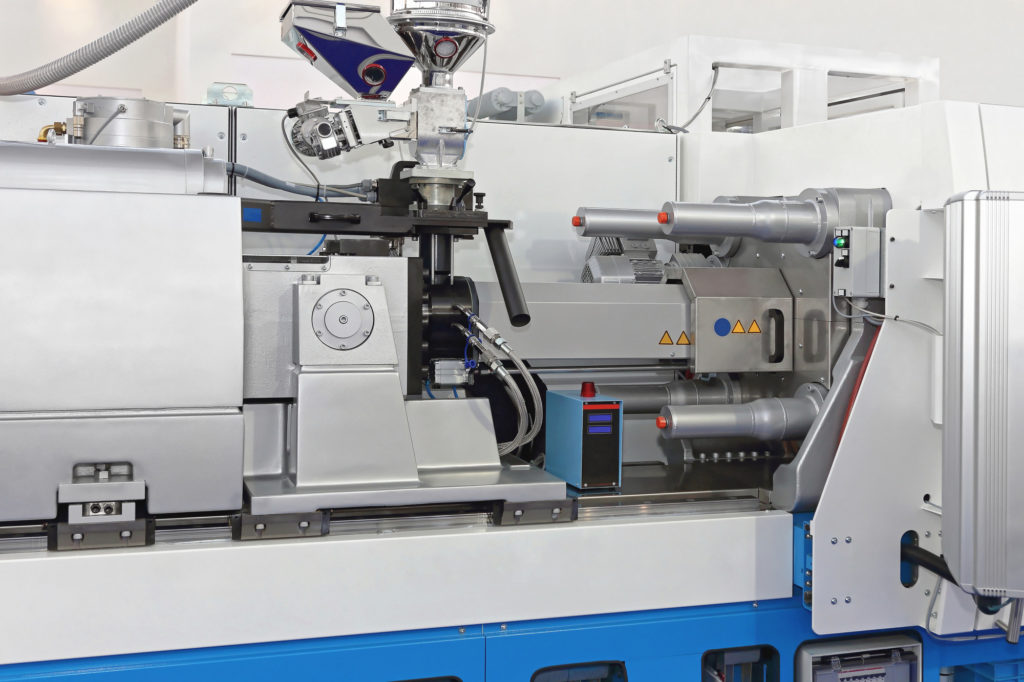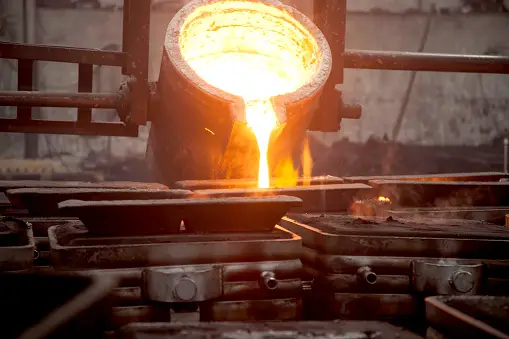Introduction
Welcome to the ultimate guide on the casting process, brought to you by Topgrid! At TopGrid, we’ve completed many casting projects, and we’ve learned a lot along the way. This blog is our way of sharing what we know with you.
Casting is a fundamental manufacturing technique that has been used for centuries to create a wide range of products. In this comprehensive guide, we will delve into the process of casting, its various methods, types, and steps.
Whether you’re new to the world of casting or looking to expand your knowledge, this guide has something for everyone.
What is Casting Process?
The casting process is a manufacturing method that involves pouring a molten material into a mold to create a desired shape. This technique is widely used to produce a vast array of products, from intricate metal components to artistic sculptures.

Overview of Casting Manufacturing Process
Casting is a versatile manufacturing process that can be adapted to suit various materials, including metals, ceramics, and plastics. It allows for the production of complex shapes and is used in a multitude of industries.
Methods of Casting
Casting can be achieved through different methods, each suited to specific applications. The most common methods include die casting, investment casting, and sand casting.
The Casting Process Steps
The casting process typically follows a series of well-defined steps. These steps ensure the production of high-quality castings.
Let’s go through the key phases:
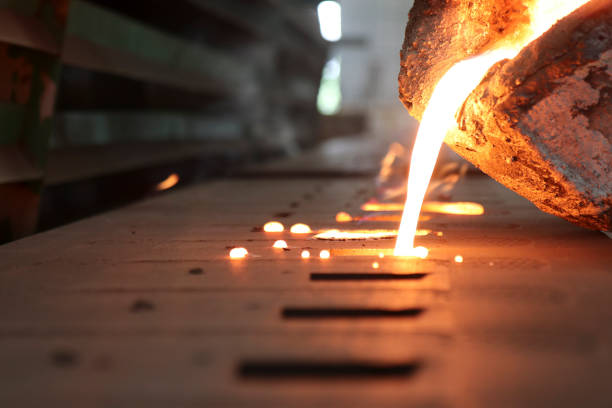
- Pattern Making: Creating a pattern that replicates the final product’s shape
- Mold Preparation: Making a mold by using the pattern.
- Melting and Pouring: Heating the material to its liquid state and pouring it into the mold.
- Solidification: Allowing the molten material to cool and solidify within the mold.
- Removal and Cleaning: Removing the casting from the mold and performing any necessary finishing, such as cleaning and machining.
Types of Casting
There are several types of casting processes, and each has its unique characteristics and advantages. Let’s take a closer look at the most prominent ones.
- Die Casting: Die casting is a precision casting method that involves forcing molten metal into a mold cavity using high pressure. It’s widely used in the automotive and electronics industries.
- Investment Casting: Also known as lost-wax casting, investment casting is a precise method for creating intricate metal components. It’s often used in jewelry making and aerospace.
- Sand Casting: Sand casting is one of the oldest and most versatile casting methods. It’s used for a wide range of applications, from creating metal sculptures to casting engine blocks.
- Centrifugal Casting Process: This process involves rotating a mold at high speed while pouring the molten material. It’s used for creating hollow, cylindrical shapes like pipes and tubes.
- Gravity Die Casting Process: In this process, molten metal is poured into a permanent mold, allowing for efficient mass production of complex shapes.
- Low-pressure Die Casting Process: In this process,casting method that uses a permanent, reusable mold to shape molten metal into intricate components.
- High-pressure Die Casting Process: In this process,casting method that uses a reusable mold to shape molten metal into complex and detailed components
Die Casting Process
Die casting is a highly precise and efficient casting method that plays a pivotal role in manufacturing industries across the globe. This section will take you through the die casting process, its advantages, and its wide range of applications.
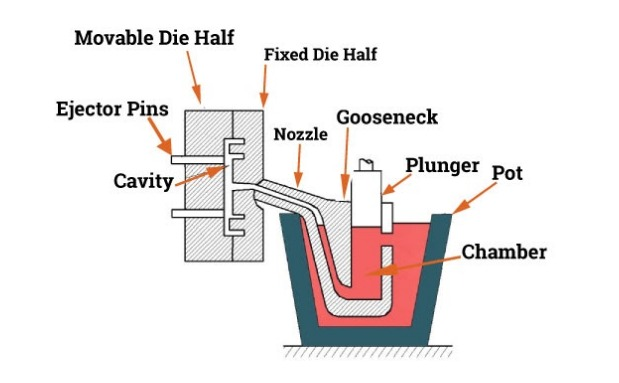
Steps in the Die Casting Process
The die casting process involves several key steps:
- Die Preparation: The two halves of the die are sprayed with a lubricant to prevent sticking, and then they are closed.
- Injection: Molten metal is forced into the die cavity under high pressure. The pressure ensures that the metal completely fills the mold.
- Cooling: The metal cools and solidifies inside the die. The exact cooling time depends on the material and part design.
- Ejection: The die opens, and the solidified part is ejected from the mold. It may still be attached to a sprue or runner, which is removed in the next step.
- Trimming and Finishing: Excess material, such as the sprue, runners, and any imperfections, are trimmed and removed. The part may undergo additional finishing processes, such as machining or surface treatment, to meet the desired specifications.
Advantages of Die Casting
Die casting offers several advantages that make it a popular choice for various applications:
- High Precision: Die casting can create complex, detailed, and dimensionally accurate parts with tight tolerances.
- High Production Speed: The process is exceptionally fast, making it suitable for mass production.
- Excellent Surface Finish: Die cast parts have a smooth, high-quality surface finish that often requires little to no additional finishing.
- Material Variety: A wide range of metals and alloys can be used for die casting, including aluminum, zinc, and magnesium.
- Minimal Post-Processing: Die cast parts typically require minimal post-processing, reducing overall production time and costs.
Investment Casting Process
Investment casting is a versatile and intricate metal casting process that has been in use for thousands of years. It derives its name from the way the casting is made: a wax pattern (or replica of the desired part) is “invested” or encased in a ceramic mold. When the mold is heated, the wax is melted and drained away, leaving behind a cavity that is filled with molten metal to create the final product.
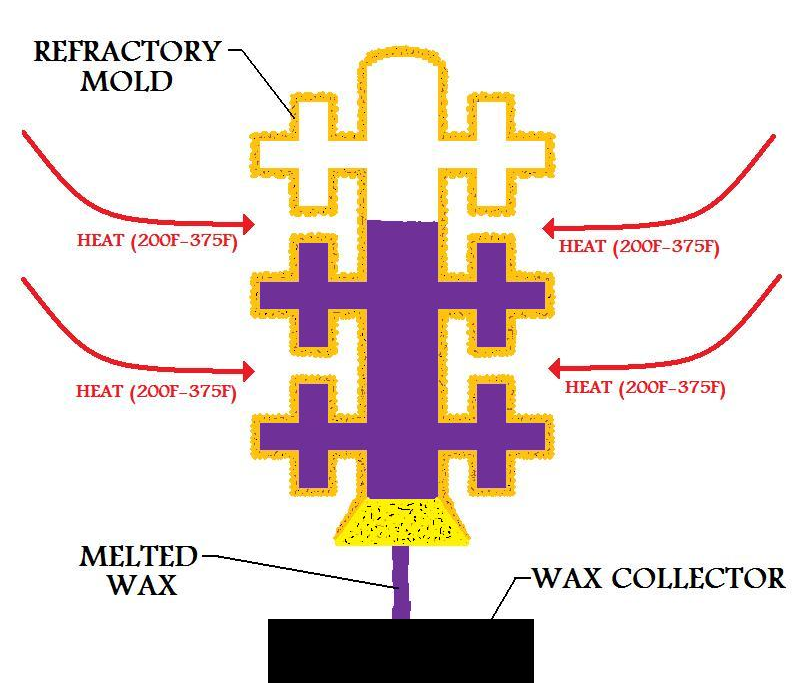
Steps in the Investment Casting Process
The investment casting process consists of several key steps:
- Pattern Creation: A wax or plastic pattern is made to replicate the final part’s shape.
- Assembly: Multiple wax patterns, called the “tree,” are attached to a central sprue. This assembly forms the core of the mold.
- Investment: The wax assembly is dipped into a slurry, coated with refractory material (ceramic), and dried to create the ceramic shell.
- De-waxing: The ceramic shell is heated to remove the wax, leaving behind a hollow cavity.
- Firing: The ceramic shell is fired to strengthen it and prepare it for the molten metal.
- Casting: Molten metal is poured into the preheated ceramic shell, filling the cavity.
- Cooling: The metal solidifies inside the shell.
- Shell Removal: The ceramic shell is broken away, revealing the investment cast part.
- Finishing: The cast part is removed from the tree, and any remaining imperfections are removed through machining or other finishing processes.
The Advantages of Investment Casting
Investment casting offers several advantages that make it a favored choice for producing complex parts:
- High Precision: This method can produce parts with excellent dimensional accuracy and intricate geometries, making it ideal for items with fine details.
- Smooth Surface Finish: Investment cast parts typically require minimal post-processing due to the fine surface finish achieved during casting.
- Design Flexibility: The process allows for the creation of parts with complex shapes and thin walls, offering design flexibility that is hard to match with other methods.
- Material Versatility: A wide range of materials, from metals like aluminum and titanium to alloys and superalloys, can be used for investment casting.
- Economical for Small Production Runs: Investment casting is cost-effective for both small and large production runs, making it a versatile choice.
Sand Casting Process
Sand casting is an ancient method for creating metal parts by pouring molten metal into a sand mold. It is an adaptable and economical approach that is widely used for both small-scale and large-scale production. Sand casting derives its name from the casting material sand.
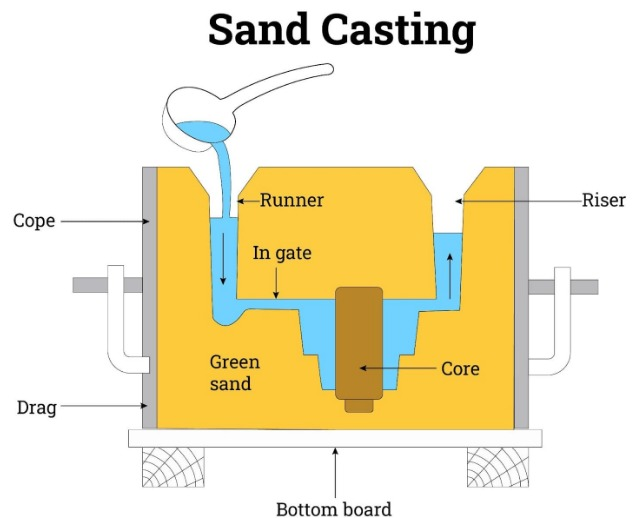
Steps in Sand Casting Process
The sand casting process follows a sequence of steps to turn a design into a tangible metal part:
- Pattern Making: A pattern, typically made from wood or metal, is created to match the desired part’s shape.
- Mold Formation: The pattern is placed in a box filled with specially formulated sand, creating a mold cavity.
- Mold Compaction: The sand is compacted around the pattern to ensure it retains its shape.
- Pattern Removal: The pattern is removed, leaving a cavity in the sand, ready for the molten metal.
- Metal Pouring: Molten metal is poured into the mold, filling the cavity.
- Solidification: The metal cools and solidifies inside the mold.
- Mold Breakdown: The sand mold is broken apart to reveal the cast part.
- Finishing: Any imperfections, excess material, or rough surfaces are removed through various finishing processes.
Advantages of Sand Casting
This time-tested casting method offers several advantages, making it a popular choice for various applications:
- Versatility: Sand casting can be used to create parts of all sizes, from small, intricate components to large, heavy objects.
- Low Tooling Costs: Compared to other casting methods, the tooling costs for sand casting are relatively low, making it cost-effective for smaller production runs.
- Complex Geometries: The sand mold can accommodate intricate part designs, including internal cavities and undercuts.
- Material Diversity: Sand casting can be used with a wide range of metals and alloys, from aluminum and brass to iron and steel.
- Quick Turnaround: Sand casting can be set up and initiated quickly, reducing lead times for production.
Centrifugal Casting Process
Centrifugal casting, also known as spin casting, is a specialized casting method used to produce cylindrical and tubular parts, from pipes and tubes to cylinder liners. It operates on the principle of utilizing centrifugal force to distribute molten metal evenly along the inner surface of a rotating mold.
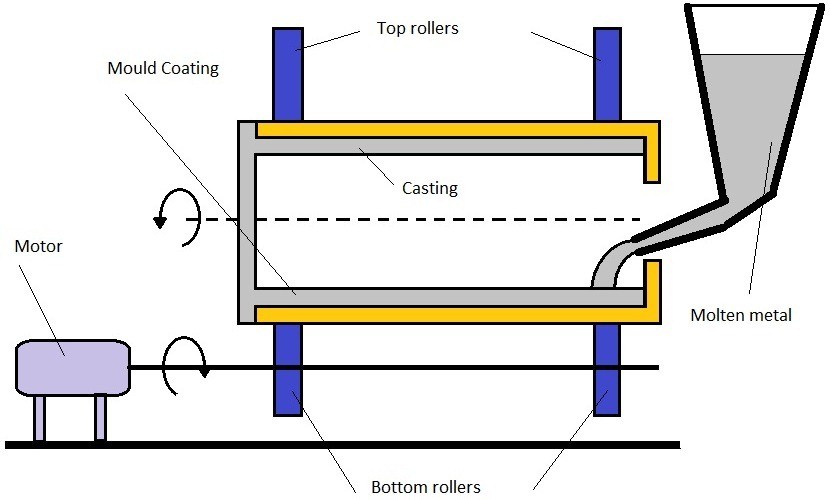
The Steps in the Centrifugal Casting Process
The centrifugal casting process involves several key steps to transform a liquid into a solid, cylindrical product:
- Mold Preparation: A cylindrical mold is preheated, and, in some cases, coated with a refractory material to improve surface finish.
- Pouring: Molten metal is poured into the spinning mold through a central sprue.
- Rotation: The mold is spun at a controlled speed, ensuring the centrifugal force pushes the molten metal against the mold’s inner surface.
- Solidification: The metal cools and solidifies as it rotates, creating a hollow cylindrical shape.
- Removal: Once solidified, the casting is removed from the mold.
- Finishing: The casting may undergo additional finishing processes to achieve the desired specifications.
Advantages of Centrifugal Casting
Centrifugal casting offers unique advantages that set it apart as an exceptional manufacturing method:
- Uniformity: Centrifugal force ensures that the molten metal is uniformly distributed along the mold’s inner surface, resulting in consistent wall thickness.
- Strength: The directional solidification during centrifugal casting enhances the mechanical properties of the component, making it stronger and more resilient.
- Minimized Inclusions: This process is effective at minimizing the presence of inclusions and impurities in the final product.
- Cost-Efficiency: Centrifugal casting is a cost-effective solution for producing high-quality, cylindrical parts with minimal waste.
- Wide Material Range: It can be used with various materials, including iron, steel, bronze, and even some non-ferrous alloys.
Gravity die casting
Gravity die casting is a casting method that uses a permanent, reusable mold to shape molten metal into the desired form. It gets its name from the force of gravity, as the molten metal is poured into the mold, allowing gravity to fill it without the need for high-pressure injections.
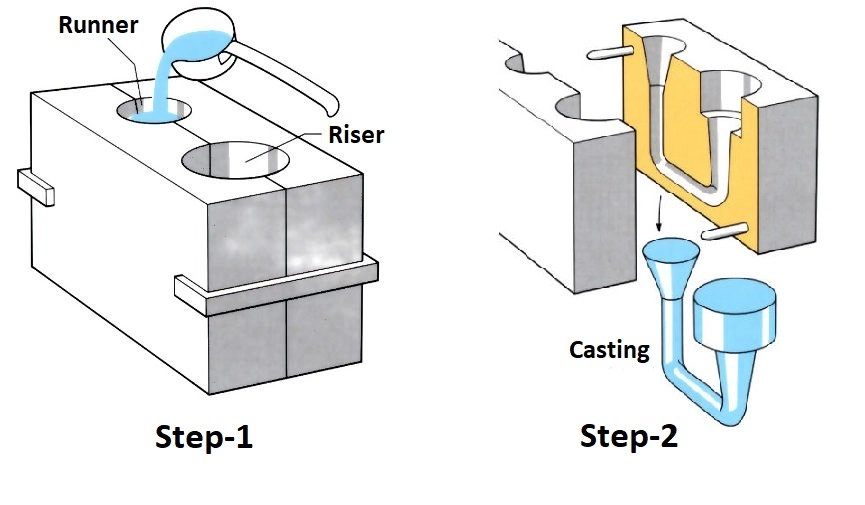
Steps in Gravity Die Casting Process
The gravity die casting process unfolds in several steps, seamlessly transforming a design into a tangible metal part:
- Mold Preparation: The permanent mold, typically made of steel or iron, is preheated to prevent thermal shock.
- Coating: The mold is coated with a refractory material to improve surface finish and extend mold life.
- Assembly: Two halves of the mold are clamped together, creating a mold cavity.
- Metal Pouring: Molten metal is poured into the mold, filling the cavity by the force of gravity.
- Cooling: The metal solidifies inside the mold.
- Mold Separation: The mold halves are separated, and the casting is removed.
- Trimming and Finishing: Any imperfections and excess material are removed through machining or other finishing processes.
Advantages of Gravity Die Casting
Gravity die casting is celebrated for several key advantages, which make it a preferred choice for manufacturing complex components:
- Dimensional Accuracy: It is exceptionally precise, capable of achieving tight tolerances and producing parts with excellent dimensional accuracy.
- High-Quality Surface Finish: Components cast using this method typically require minimal post-processing, thanks to the smooth surface finish achieved during casting.
- Material Versatility: Gravity die casting can accommodate a wide range of materials, including aluminum, copper, and various alloys.
- Cost-Efficiency: The process is cost-effective for both small and large production runs, making it versatile and economical.
- Rapid Production: Setting up gravity die casting is quick, allowing for fast turnaround times in production.
Low-Pressure Die Casting
Low-pressure die casting is a precise and controlled casting method that uses a permanent, reusable mold to shape molten metal into intricate components. Unlike high-pressure die casting, where metal is forcefully injected into the mold, low-pressure die casting relies on a low-pressure environment to gently fill the mold cavity.
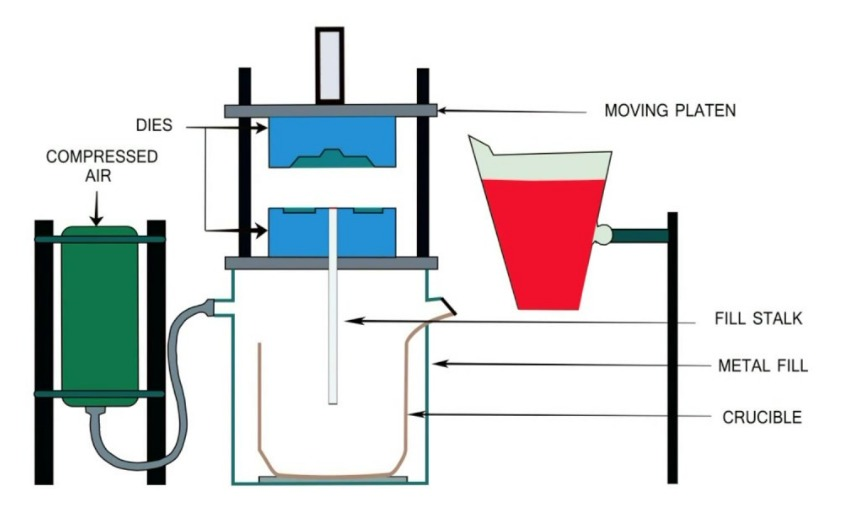
Steps in Low-Pressure Die Casting Process
The low-pressure die casting process involves a sequence of steps that transform a design into a tangible metal component:
- Mold Preparation: The permanent mold, typically made of steel or iron, is preheated to prevent thermal shock.
- Coating: The mold is coated with a refractory material to improve surface finish and extend mold life.
- Pressure and Filling: The mold is clamped, and molten metal is introduced into the mold cavity under low pressure.
- Solidification: The metal cools and solidifies inside the mold.
- Mold Separation: The mold halves are separated, and the casting is removed.
- Trimming and Finishing: Any imperfections and excess material are removed through machining or other finishing processes.
The Advantages of Low-Pressure Die Casting
Low-pressure die casting offers several key advantages, making it a preferred choice for manufacturing complex and high-quality parts:
- Excellent Precision: It is known for achieving tight tolerances and producing parts with exceptional dimensional accuracy.
- Low Porosity: The controlled pressure environment reduces the likelihood of porosity, resulting in stronger and more reliable parts.
- Reduced Oxidation: Low-pressure casting minimizes exposure to oxygen during the process, preserving the integrity of the metal.
- Excellent Surface Finish: Parts cast using this method typically require minimal post-processing, thanks to the smooth surface finish achieved during casting.
- Material Versatility: Low-pressure die casting can accommodate a wide range of materials, including aluminum, magnesium, and various alloys.
- Rapid Production: The process allows for quick setup and short lead times in production.
High-Pressure Die Casting
High-pressure die casting is a precise and high-speed manufacturing method that uses a reusable mold to shape molten metal into complex and detailed components. It derives its name from the high pressure applied to force molten metal into the mold cavity.
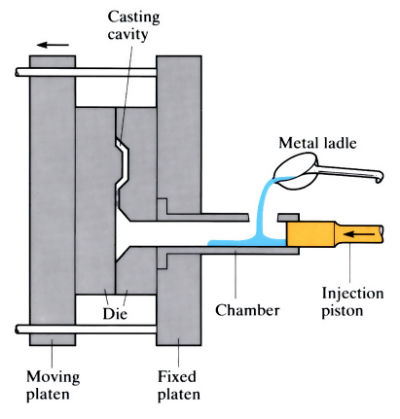
Steps in the High-Pressure Die Casting Process
The high-pressure die casting process unfolds in a sequence of steps that transform a design into a tangible metal component:
- Mold Preparation: The mold, typically made of steel, is preheated to withstand the thermal stress.
- Injection: The mold is clamped, and molten metal is forcefully injected into the mold cavity at high pressure.
- Solidification: The metal cools and solidifies inside the mold.
- Mold Separation: The mold halves are separated, and the casting is removed.
- Trimming and Finishing: Any imperfections and excess material are removed through machining or other finishing processes.
The Advantages of High-Pressure Die Casting:
High-pressure die casting offers several key advantages, making it a preferred choice for manufacturing intricate, high-quality components:
- Exceptional Precision: It is known for achieving tight tolerances and producing parts with outstanding dimensional accuracy.
- High Production Speed: High-pressure casting is extremely fast, making it ideal for high-volume production.
- Cost-Efficiency: The process can be highly cost-effective for large production runs, with minimal waste.
- Material Versatility: High-pressure die casting can accommodate various materials, including aluminum, magnesium, and zinc.
- Complex Geometries: It is well-suited for creating components with intricate shapes, thin walls, and undercuts.
- Excellent Surface Finish: Parts cast using this method typically require minimal post-processing, thanks to the smooth surface finish achieved during casting.
Conclusion
The casting process is an integral part of modern manufacturing, offering the ability to create intricate shapes and a wide range of products. Understanding the various methods and types of casting, along with the critical steps involved, is essential for anyone in the manufacturing industry.
In this comprehensive guide, we’ve covered the basics of casting and provided an overview of the most common casting processes. Whether you’re interested in die casting, investment casting, or sand casting, Topgrid is here to help you explore the fascinating world of casting and its numerous applications.

